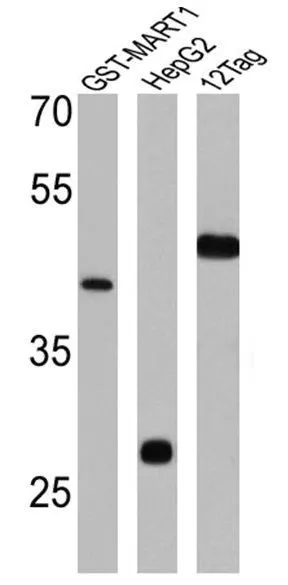
WB analysis of 25 ug of 293T cells transfected with GST-MART1 (Lane 1), HepG2 cells (Lane 2) and 293T cells transfected with 12 Epitope Tag (12Tag) (Lane 3) using GTX82896 GST Epitope Tag antibody. Dilution : 1:5000 (GST and 12Tag) and 1:1000 (HepG2)
GST tag antibody
GTX82896
Overview
- SupplierGeneTex
- Product NameGST tag antibody
- Delivery Days Customer9
- Application Supplier NoteWB: 1:1000-1:5000. *Optimal dilutions/concentrations should be determined by the researcher.Not tested in other applications.
- ApplicationsWestern Blot
- CertificationResearch Use Only
- ClonalityPolyclonal
- Concentration1 mg/ml
- ConjugateUnconjugated
- HostRabbit
- IsotypeIgG
- Scientific DescriptionEpitope tagging is a powerful and versatile strategy for detecting and purifying proteins expressed by cloned genes. To utilize this feature, protein expression vectors are typically engineered with a nucleotide sequence that encodes the peptide epitope tag. The gene of interest is cloned in-frame relative to the tag and, upon expression, the protein of interest is synthesized as a fusion protein with the peptide tag. Fusion protein detection and/or purification is mediated by highly specific antibodies to the engineered peptide, thus eliminating the need for antibodies to proteins from each newly cloned gene. Commonly used epitope tags include glutathione-S-transferase (GST), c-myc, 6-histidine (6X-His), FLAGR, green fluorescent protein (GFP), maltose binding protein (MBP), influenza A virus haemagglutinin (HA), b-galactosidase, and GAL4. FLAGR and anti-FLAGR are registered trademarks of Sigma-Aldrich Biotechnology Co.
- ReactivityOther Species
- Storage Instruction-20°C or -80°C,2°C to 8°C
- UNSPSC12352203
